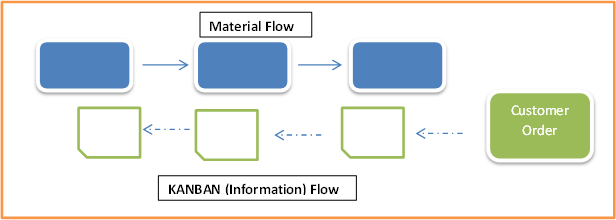Worldwide, Just in Time production and Single Flow manufacturing are gaining attention and more and more companies are adapting to these methodologies. There are a lot of tools and techniques like Kaizen, Kanban, Jidoka, etc. to achieve LEAN manufacturing.
KANBAN is a LEAN and JIT tool to control the flow of raw materials and Work In Progress into and out of the production system. It was developed by Taichi Ohno in Toyota to streamline the operations. It is one of the ways and means to achieve Just in Time Manufacturing. KANBAN can be used for both Batch Processing and Single Flow Manufacturing.
KAN means Card; BAN means ‘Signal’.
The Concept of KANBAN
KANBAN is a signaling technique, which communicates the requirement of items needed by later processes to the preceding processes. Thus it induces ‘Pull flow’ into the system against the traditional push flow.
KANBAN and JIT were based on the inspiration from Super markets that were introduced in American towns. These super markets display products which are picked in required quantity by the customer. Once the stock depletes to a required amount, it is replenished to the original levels.
The same concept was introduced in a production floor with the help of KANBANs. Once the order is received from the customer, the instruction is sent through KANBAN card to the last process. This process sends the completed product in quantity as indicated in the KANBAN card, in return. Usually an empty bin is sent along with the KANBAN card. This chain of sending KANBAN and receiving items in exchange goes till the first step and even to the suppliers.

Thus KANBAN aims to convert the entire process into a pull system. The goal of this is to reduce inventory by producing only in numbers that are required by the customer, and replenishing only the minimum required stock/utilized stock.
Rules of KANBAN System
There are certain thumb rules for KANBAN system: They are
- The last process requests the previous process the number of items that needs to be processed
- The preceding process sends the items only after KANBAN is received
- No goods are sent or received without KANBAN
- No KANBAN moves with a defective product
- Always attach KANBANs with some goods or request
- As the process matures, the number of KANBANs should be reduced
These rules should strictly be followed to implement a KANBAN system.
With advancement of technology, KNBAN which was designed typically for manufacturing units is now used across industries like IT, project management etc. Even the ERPs are designed with features of KANBAN for supply chain management and logistics.
